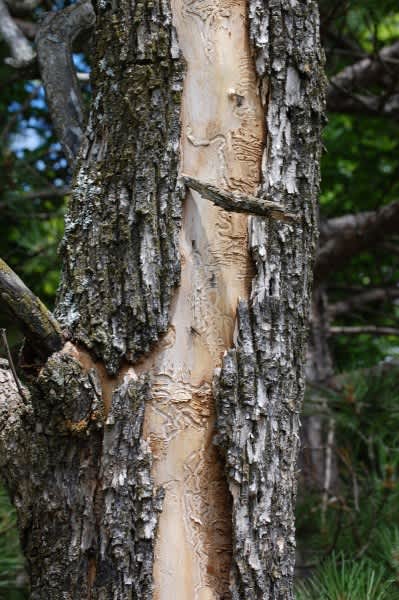Emerald Ash Borer and Your Hunting Land
Derrek Sigler 07.16.14

Like many of you, the area I deer hunt has a mix of hardwoods bordering some open ground that I’ve set up food plots in. The hardwoods have been a mix of maple and ash, with a few others mixed in. The ash trees have been around the longest and have provided the biggest, straightest trees for attaching stands to. Thanks to a pesky bug, things are changing for me this fall.
A new pest was detected in Southeast Michigan back in 2002: the emerald ash borer (EAB). In its adult form, the borer is a metallic green beetle that is roughly one half-inch in length, munches on ash leaves, and is not all that hard to contain. However, its larval form is the real stinker. The larvae bore through the inner bark of trees, disrupting the ability for water and nutrients to be transported. In short order, trees infected by EABs die off.
It has spread quickly, moving from Michigan into the Midwest, the East Coast, parts of the South, and beyond. The bug has likely been responsible for the death of hundreds of millions of trees.
I have access to three separate 40-acre parcels of mixed hardwoods, all of which have some geographic isolation from the others, but within reasonable driving distance. All three parcels have evidence of massive ash tree die-off, especially the larger, older-growth trees.
The negatives
The negative impacts of the emerald ash borer’s spread are easy to see. The death of large numbers of hardwood trees, has dramatically changed the landscape of our forests. A multi-state planning commission is looking at possible ways to eradicate the bug, but so far little progress has been made.
As with any infestation issue, one of the major downfalls is cost. The economic impact of EAB can’t be calculated at this time because there is no real way of determining how fast and how wide it has spread. The wood that is infected cannot be used for lumber due to scarring.
There is also a quarantine zone in place in these states preventing the transport of any wood for lumber or firewood, in an effort to help contain the spread. Within the quarantine zones, the cost of firewood has dropped remarkably with the abundance of dead ash available. While that is a plus to the buyers, those who depended on the money from firewood sales have seen additional hardship.
Dead, dry timber in the forest also creates additional fire hazards. If you don’t think that is an issue, just look to Alaska. This past spring, extremely dry conditions due to a mild winter led to forest fires that were very hard to contain due to an overabundance of dead, dry spruce trees that were killed from a beetle infestation. One fire alone burned almost 200,000 acres of forest and threatened many homes.

The positives
You always have to see some positives with these sorts of scenarios and there are a few, especially for us hunters. With death there is almost always new life, and with the death of old, tall ash trees, there are opportunities for new beginnings.
For one, if you take out some of the forest ceiling, the undergrowth flourishes. Deeper light penetration into the lower “altitudes” of the forest allows for the growth of more food sources for fauna, as well as that all-important cover. Part of one of my parcels had an area where we had to remove a large portion of the tall trees. Then another project removed some of the topsoil, exposing sand underneath. I went back in and replanted the area with some native grasses and pines. Soon other plant life took a foothold, and now the area is thick and vegetative. It is a major corridor for deer and turkey on my property now. The value of letting the smaller stuff grow up can’t be understated.
If you burn wood for heat, a die-off can also be a positive. I’ve been looking into putting in an outside wood boiler on my property just because I know I have enough wood to last for a few years.
What can you do?
The most important thing you can do to help with EAB control is monitor your woods, whether it is your own property,or public land you use. The multi-state partnership I mentioned above runs an excellent website to help manage EAB. There you can find information on insecticides, control measures, and the latest research on EAB.
You can also do one of my favorite things: grab the chainsaw and get to work! Be sure you follow safety rules and know what you’re doing, but cut those dead trees down when you can. I’m annoyed that I need to do a few things differently this fall with stand placements, but it’s worth it.

